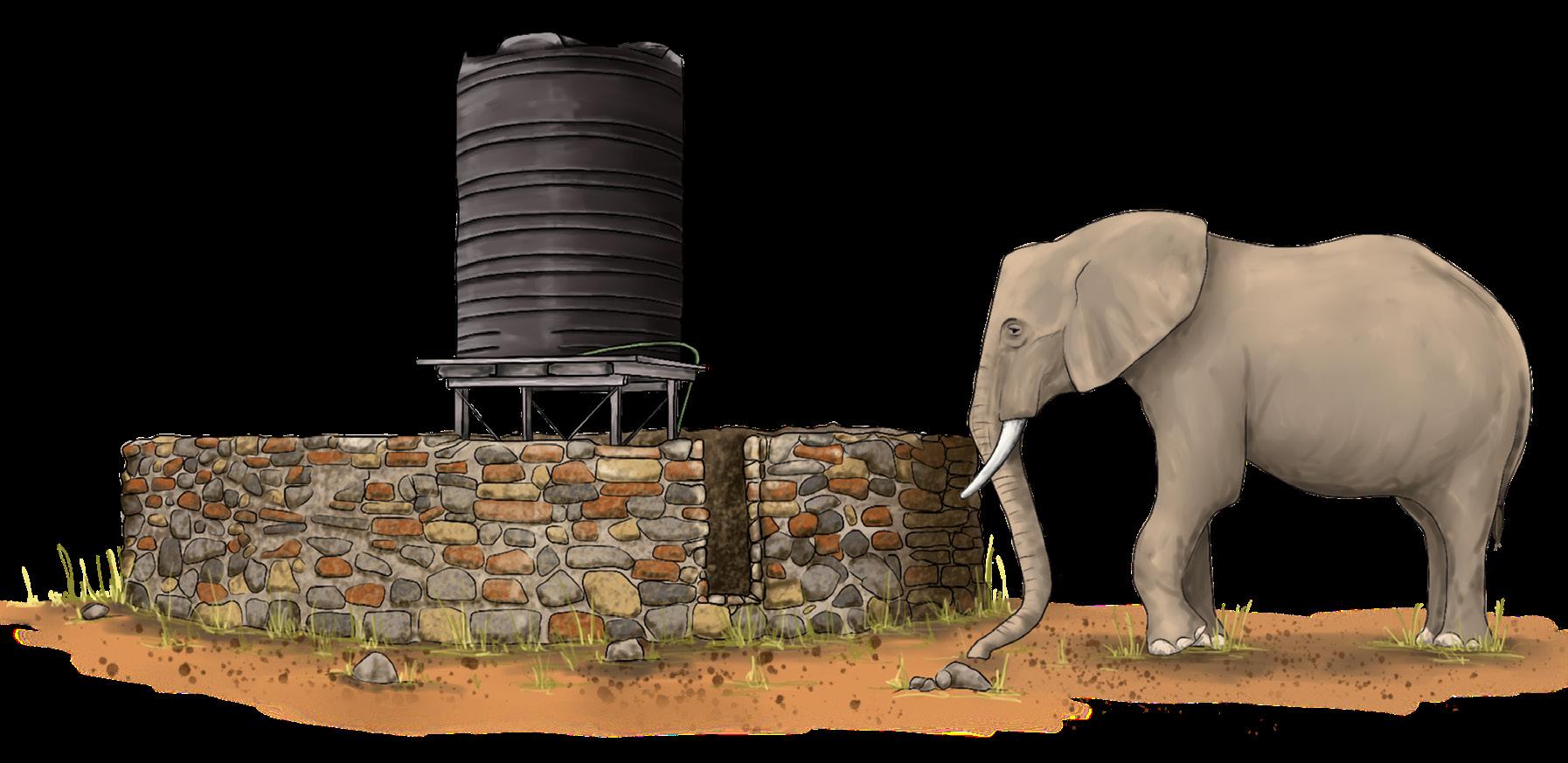SHARED/ALTERNATIVE WATER POINTS
The past few years have brought prolonged drought periods and water shortages.




stored in villages and can break pipes, water tanks and storage units to access water.



Vulnerable women and children can be negatively affected as they often have to collect water for the household.

1.
One solution is to set aside alternative watering sites for elephants, at the same time defining community water points to allow livestock to drink and women to wash safely.
Water points for elephants must be left undisturbed by livestock dung or human scent.

This reduces conflict at the same water point and elephants can learn to avoid the area used by the community.
Communities can demark with posts/pillars where they have decided to leave water spaces for elephants to come down to drink.
Boreholes














Livestock and herders will quickly learn that this is a safer way to water cattle when elephants share the same water site.
Boreholes open access to deeper ground water that is often not polluted/contaminated.


The most ideal is solar powered pumps, that removes financial pressure from farmers if they were powered by electricity.
Hand pumps can draw up water but require intensive physical labour.
Some villages also use round abouts to drive the water pump.
As the children spin, water is pumped from underground into a nearby protected tank.

Excess water is directed from the tank back underground.
Extreme water extraction can also lower water levels in natural streams and swamps.

Read more on http://www.playpumps.co.za/index.php/how-it-works/
2.
It is important to survey the land before installing boreholes as excessive extraction can reduce ground water levels that might impact farm yield.
Location: Namibia


Elephant drinking dams are built a few hundred meters outside the village.
Case studies










See Water Tank Protection for more
These dams are filled from the same borehole that fills water tanks for people to access.
Livestock can also be watered at these outside dams.
All water storage facilities must be well protected to reduce human-elephant conflict.
Using stone walls or sharp white rocks are a good way to keep elephants from reaching and pulling down the water tanks/pipes.



Solar water pumping systems are relatively simple, require little maintenance, and provide independent water pumping schemes.

They are suitable for rural and remote water supply where the electricity is not available.

: Read more on: - EHRA Sturdy Stone Wall

-Solar powered water source helps reduce human wildlife conflict and provides additional community benefits. WWF
Nkolale community development organisation in Maasai Mara, Kenya, built a 100,000-litre underground tank that collects water from deep natural springs
That water is then pumped into an outer tank, where some of it is directed to open wells further away from the village for wildlife to access.
More water is pumped by gravity over 13km to serve the surrounding village, schools and health facilities.
Read more on Spring water conservation cuts down on human-wildlife conflict in Kenya

3.
Communities do not have to walk long distances to collect water, reducing their chances of encountering elephants on the path/at water points.

Safe access to water for people, livestock and elephants.
They are not exposed to water-borne diseases that often come with using water that wildlife also shares.

Reduced cases of human-elephant conflict as elephants have access to water, without having to break water tanks and clash with livestock and people.

Increased positive attitudes towards elephants.
Availability of clean water also increases crop production for farmers to provide to their families and also sell to the market.
Caution tips:

It is important for villagers to remember to pump the elephant dam full with water, so elephants can drink and safely leave the community area. If alternative water points provided are not set up separately, they will attract both humans and wildlife to the same point, increasing conflict




Ensure children are educated on which area of river banks and dams are safe for them to access, and not to cross the marked boundaries. Keep safe distance from elephants around water points.


cons -
















Cost of installing either a bore hole or underground water storage system and maintaining it is high and may require external financial support for both installation and maintenance.


A budget for maintenance needs to be worked on into finance plans to prevent metal pipes from eroding and must be maintained to prevent water leaks.

If the elephant dam is empty and the tanks are protected, elephants will try to break walls to reach the tanks.

Credits and Disclaimer:
We have collected this information from multiple sources. Main sources include: The Elephant drinking dam idea developed by Elephant Human Relations Aid (EHRA), Namibia. For more information on Alternative Water Points, literature and resources used, see References. More research may be required before each site-specific implementation. Safety and caution is advised with all the methods presented in this toolbox.

*Save the Elephants is not liable for any costs, damages or injuries incurred by the use of these methods.

PROS +
Produced by Save the Elephants www.savetheelephants.org Illustrations by Nicola Heath Made in Kenya 2023
4.
50 meters






































